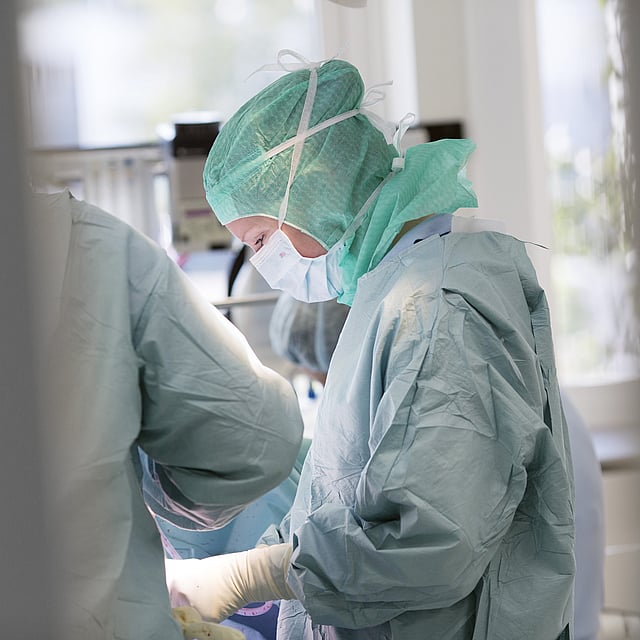Cruciate ligament injury in dogs #
Unlike in humans whose cruciate ligament usually tears because of sudden extreme stresses, as in sports injuries, rupture of the cruciate ligament in the dog is usually the result of degenerative disease. The more anterior of the two cruciate ligaments is affected more often. These normally prevent the thigh bone (femur) and shin bone (tibia) from shifting relative to each other on weight-bearing. If the cruciate ligament is torn, the “drawer sign” can be elicited: the lower leg can be moved forward. You will find further information about cruciate ligament tears in dogs at this link.
TTA in dogs: what is that? #
TTA in dogs is an operation on the bone performed under general anaesthetic. Tibial tuberosity advancement (TTA) describes a change in the anterior side of the tibia where the patellar tendon is attached. During the operation the anterior part of the tibia is divided vertically with a bone saw and reattached with a spacer. Depending on the system, attaching the spacer with several screws may suffice or the bone fragment is additionally fixed at the side with a stable plate.
TTA in dogs alters the biomechanics of the knee joint and patellar tendon so that the anterior cruciate ligament becomes redundant and the joint is stable.
TTA in dogs: postoperative treatment #
Directly after the operation dogs are given pain relief as well as substances that support cartilage production in the joint. These are usually given for at least 2 months. Directly after the operation the animals often start to put weight slightly on the leg. This is not a problem as the implants confer basic stability. On no account should there be any severe or jerky loading of the joint.
TTA in dogs: weight-bearing #
After TTA you should give your dog enough time for the bones to knit. In the first 6-8 weeks after the operation, he or she must be kept strictly on the leash so as to avoid sudden stress on the joint due to jumping, playing, etc. Once the pain has gone, dogs like to forget that their knee is not yet fully fit again so it is up to you to prevent bigger strains. Dogs should also not be overweight as this would be an additional strain for the joint.
The first walks are short and slow and the duration of exercise is then increased slowly. Your vet will explain to you in detail how to carefully get your pet moving again and so achieve optimal healing. Exercise stimulates the circulation and repair processes and slowly builds up the muscles necessary for keeping the joint stable in the long term. Physiotherapy can also be useful after a TTA operation for cruciate ligament tear.
TTA in dogs: complications #
Possible complications of TTA in dogs include:
- Wound infections
- Implant loosening
- Delayed bone healing
- Meniscus damage
- Inflammation of the patellar (knee extensor) tendon
Depending on the severity of the complication, the course of healing may be delayed or a further operation may be necessary. Despite these possible negative effects, surgical management of cruciate ligament tears in dogs is much more successful than conservative treatment with medication.
By the way, the sooner this surgery is performed after the onset of lameness due to a cruciate ligament tear, the fewer the late complications such as osteoarthritis and meniscus damage and the greater the probability that the dog will be able to walk without pain after the operation.
TTA in dogs: costs #
In Germany, fees for veterinary services must be charged according to the Veterinary Fee Schedule (GOT). In addition to the vet’s fee, there will also be the costs of medications, dressings, suture materials and implants. Before a potential TTA operation on your dog, the vet will discuss the costs with you.
Cruciate ligament injury in dogs TTA – what are the alternatives to cruciate ligament surgery? #
Besides TTA, ligament replacement and TPLO are widely employed cruciate ligament operations.
Surgical ligament replacement involves actual replacement of the torn ligament, tightening of the joint capsule or use of suture stabilisation – a tape attached outside the joint that is intended to take over the function of the cruciate ligament.
TPLO (tibial plateau levelling osteotomy) is just as promising as TTA as a method of cruciate ligament surgery in dogs. In TPLO, however, a different part of the joint, namely, the joint surface of the tibia, is altered. There is more information here.
TTA and TPLO are good methods for big and heavy dogs and for those that already have severe osteoarthritis in the knee. Ligament replacement would be less suitable for these. In serious cases, your vet will naturally discuss with you whether TTA is a possibility for your dog after a cruciate ligament tear or which method is more appropriate.
© AniCura
